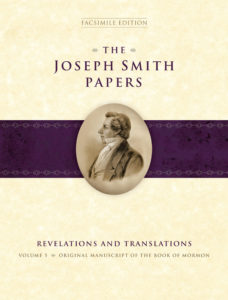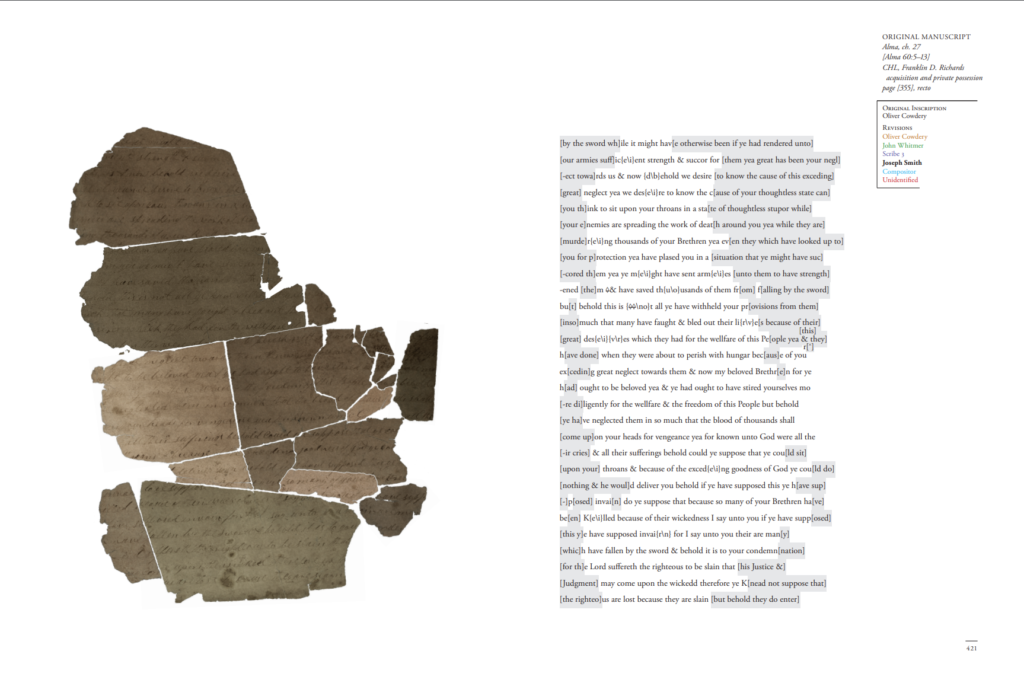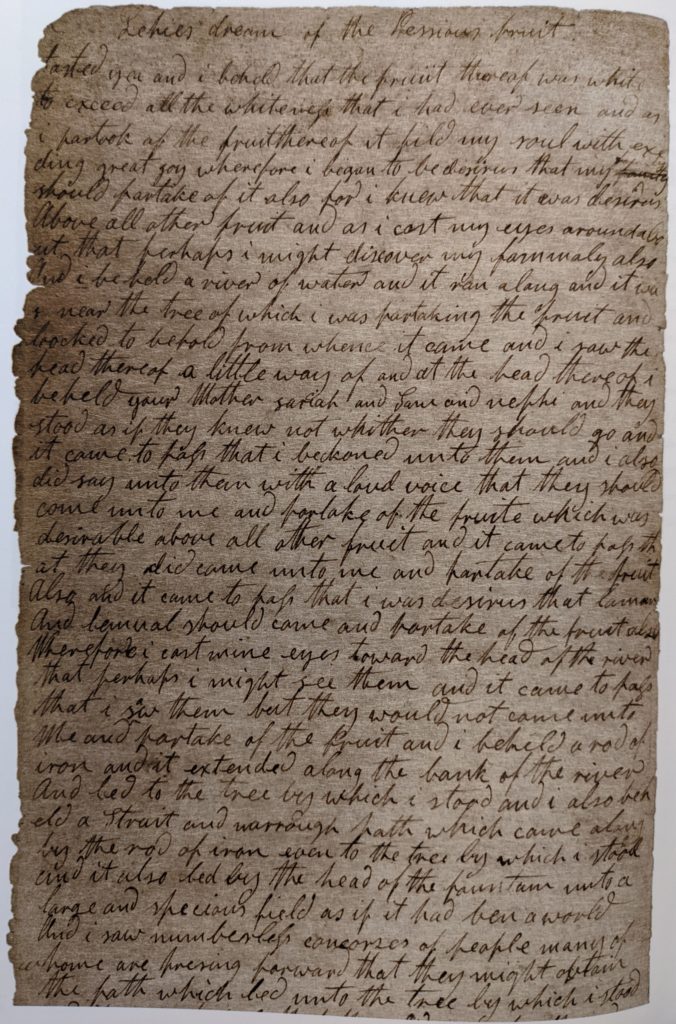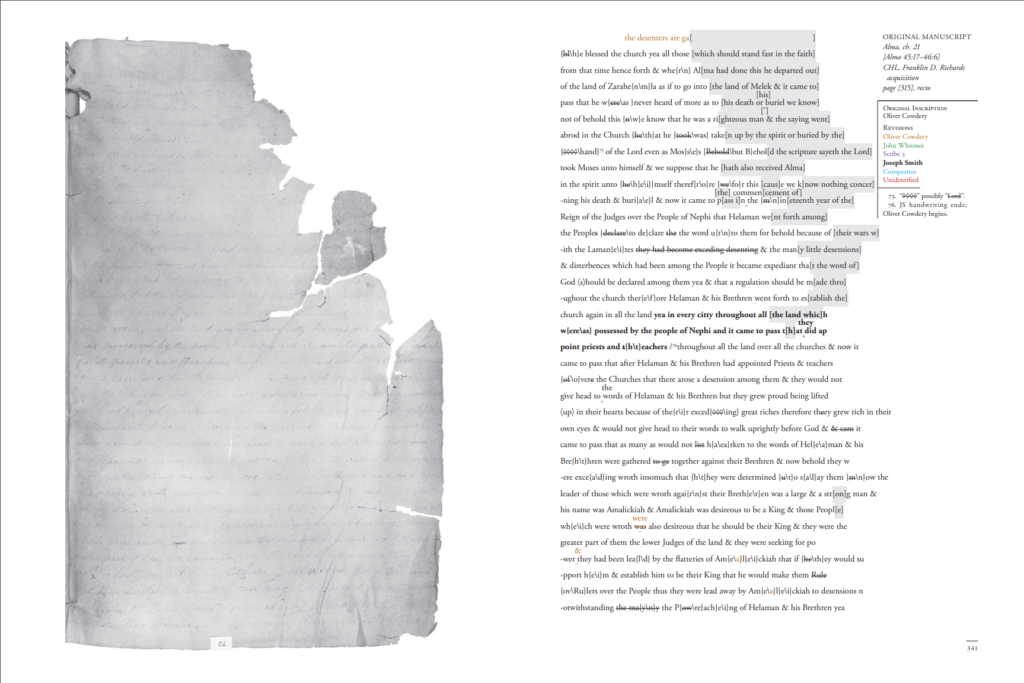
This is one of the larger (a little over 9 inches by 12 inches) facsimile editions in the Joseph Smith Papers series. Weighing nearly 10 pounds, with 800 pages, I believe it is the largest single book in the series. It may fit better on a table than a shelf, and is certainly easiest to peruse that way. But it is a fitting presentation of the extant pieces of the original manuscript of the Book of Mormon.
Unfortunately, only around 28 percent of the original manuscript still exists, and most of it is in very poor condition. It was stored for safekeeping in the cornerstone of the Nauvoo House in 1841, but when it was found over 40 years later during a remodel by Lewis Bidamon, it had been badly damaged due to the cornerstone apparently not being weatherproof despite precautions that had been taken. Bidamon gradually gave bits and pieces of it away over the years to visitors, but most of what remains is thought to now be at the Church History Library, the Wilford Wood Museum, and the University of Utah.
Over the years many of the pieces have deteriorated even further through faulty conservation attempts and mishandling. Fortunately, some of them were photographed when they were in better shape, which has made it easier to identify which of the fragments belong together. The ones in the Church’s possession have now been carefully encapsulated in materials that should preserve them for the future.
The Church History Department used multispectral imaging to take high resolution pictures of each page and fragment, and the most readable versions are published in this book. This means the photos in the book are now more useful for study than the actual fragments would be. Less readable versions are also contained in an appendix, so comparisons can be made where wanted.
Royal Skousen has been working for many years on the Book of Mormon Critical Text Project, transcribing the original and printer’s manuscripts and analyzing and comparing them with the various editions that were printed during Joseph Smith’s lifetime. His work is used in this volume, both as a transcription of the surviving portions and to fill in the holes around them. The parts that aren’t actually extant have had gray boxes painstakingly added around them to make them identifiable at a glance.

There is also color coding in the transcription to identify who the scribes were and, where changes were later added, who they were done by. The scribes have been identified as Olivery Cowdery, John Whitmer (this is a new identification), and Joseph Smith. Other scribes are known or have been reported to have worked with Joseph – Emma Smith, Martin Harris, Samuel Smith, Christian Whimer, and Reuben Hale – but their handwriting has not survived as far as has been identified. However, there is one scribe still unidentified, who also made later revisions, and there are also revisions made by another unknown hand. Revisions made by Oliver Cowdery, John Whitmer, and Joseph Smith have been identified. Interestingly, I find the unknown “Scribe 3” to be the most readable.

Joseph Smith’s handwriting appears for 28 words. According to Grant Hardy’s introduction to Royal Skousen’s The Book of Mormon: The Earliest Text, “At Alma 45:21, Oliver writes down an incoherent phrase while taking down the dictation, and in the next verse Joseph takes over mid-sentence to write twenty-eight words (this is the only time Joseph’s handwriting appears in the manuscript). Apparently, Oliver was momentarily incapable of continuing, which required Joseph himself to transcribe those words so they wouldn’t be lost.” [1]

As with some other volumes of the Joseph Smith Papers series, there is an appendix containing some disputed documents. In this case, it is “Leaves Acquired from the University of Chicago.” There is disagreement about their authenticity, since they have been associated with the forger Mark Hofmann, though there is actually no evidence for it. For the first time in the series, there are two essays explaining the positions of the editors, with Robin Jensen arguing for their authenticity and Royal Skousen arguing against. (Something similar may have been very appropriate in some earlier volumes, as well.)
The book also contains the usual timeline of Joseph Smith’s life, a map of his residences, an introduction that explains the history of the production of the original manuscript and its history afterward, the editorial method (specific to this volume), and a six page “Note on Photographic facsimiles.” In the back, besides the appendices already mentioned, there is a list of updates that Skousen made to the transcription since it was published in 2001. There is also a reference section with a “Book of Mormon Chronology for the Years 1823-1830” and a list of cited works.
The only complaint I have about this book is that while the key for the original scribe is accurate for each page, the list of color coded names under “Revisions” appears to be the same throughout the entire volume. This was rather confusing at first, since I expected all the names to apply on the first page I looked at, which was not the case (and never is). It would have been more helpful to have them match each page, so you could look at a glance to see who made changes like you can with who the scribes were on each page.
I have really enjoyed being able to read the actual handwriting of the original scribes of the Book of Mormon. It is quite a different experience than reading the published book. I think the way the book is laid out is ingenious in how it shows both the manuscript and transcription of words both intact and missing. This book makes the original manuscript accessible for thorough study by scholars as well as letting it be enjoyed by anyone who values the Book of Mormon as scripture.
[1] Skousen, Royal, ed. The Book of Mormon: The Earliest Text. New Haven, CT: Yale University Press, 2009, page xv.
 Trevor Holyoak is the Vice President of FAIR. He has been actively involved with FAIR for many years and received the John Taylor Defender of the Faith Award in 2014. He graduated magna cum laude from Weber State University with a BS in computer science and now works as a programmer and systems administrator. He is currently serving as a stake emergency preparedness director and in the leadership of the Utah Valley Amateur Radio Club. He and his wife have five children and live in Cedar Hills, Utah.
Trevor Holyoak is the Vice President of FAIR. He has been actively involved with FAIR for many years and received the John Taylor Defender of the Faith Award in 2014. He graduated magna cum laude from Weber State University with a BS in computer science and now works as a programmer and systems administrator. He is currently serving as a stake emergency preparedness director and in the leadership of the Utah Valley Amateur Radio Club. He and his wife have five children and live in Cedar Hills, Utah.
The post Book Review: The Joseph Smith Papers Revelations and Translations Volume 5: Original Manuscript of the Book of Mormon (Facsimile Edition) appeared first on FAIR.
Continue reading at the original source →



